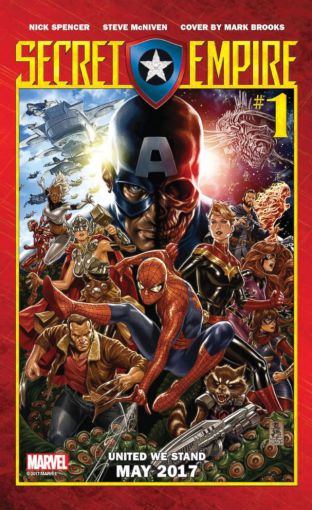
Having dutifully followed and loved every bit of Nick Spencer’s epic and controversial run on Captain America: Steve Rogers (you can read the bumper reviews here and here) I came to Secret Empire with great anticipation and interest.
Spencer’s work in this complex, non-linear, long-playing storyline has been absolutely superb: and the build-up for months has been probably been the best ongoing storyline I’ve read since Johnothan Hickman’s Avengers’ run that led in to the Secret Wars (2015) event.
Therefore, Secret Empire – which was the envisioned end-game for all these months of build-up – had a lot to live up to.
Did it manage it? As usual here, I’ll go through each chapter from #0 – 9 and then finish with an overview.
Secret Empire #0, from the very start, shows us the piece of the puzzle we’ve been missing all these months: a prologue to show us Steve Rogers at the very start of his confusing, non-linear, one-man mission to seize power. Here, Rogers is receiving his final instructions before being sent into his new life.
The non-linear dynamics of this storyline have been one of the most interesting things in Spencer’s arsenal: and it is artfully employed here right at the outset, reminding us of the scope of this narrative.
Beyond that prologue, however, Secret Empire #0 focuses squarely on the present-tense narrative; and, specifically, on Rogers’ final moves to eliminate any obstacles and take full control of the United States. This is all compelling stuff. After months and months of storytelling, this is finally where Rogers’ betrays all his friends and reveals his true colours. There are two strong, specific micro-betrayals here (in addition to the bigger, more general Palpatine/Order-66 style operation): his betrayal of Sharon Carter and his cold betrayal of Carol Danvers.
These occur at the same time and are dramatically engaging, especially the heartless way he deals with Carol and Alpha Flight, leaving them trapped in space – it’s the cold way he dismisses Danvers that is most striking. He informs her of the situation – and his true allegiance – over a viewscreen (face to face, as it were).
His simple parting short of “Goodbye, Carol” is arguably the most tense moment of this book. This whole sequence reminded me very much of Dukat betraying everyone to join the Dominion in the Deep Space Nine episode ‘By Inferno’s Light’ – right down to the moment Dukat tells Kira over a viewscreen “goodbye, Major – you and I on the same side never seemed quite right”.
More broadly, of course, ‘Cap’ is betraying everyone else too – but it’s a moment we’ve seen coming for a long time. Nevertheless, it’s nice to see it unfolding, and this book does a good job of bringing in various, multiple characters and situations to give the thing its sense of scale. The key pieces here are Rogers’ and Hydra’s need to eliminate or neutralise all potential opposition to their new order, which necessitates Carol and co being exiled from Earth via the planetary shield and scores of heroes being deliberately trapped in a New York that is henceforth cut off from the rest of the country via dark magic (and via the ‘dark hold’).
I also really like the inclusion of the ‘Dark hold’ in the plan – as I’ve been watching and loving the superb fourth season of the Agents of S.H.I.E.L.D TV series.
Needless to say, the tension here is high; and this is a good final push into the ‘Secret Empire’ paradigm.
Secret Empire #1 takes us more into how this new regime functions – both from the regime’s-eye-view of things and from the street level (and the level of the resistance). This multi-faceted approach was really the only effective way to tell this story.
What it means is that we get the whole picture, particularly the sense of both how the propaganda is distilled and disseminated from the Hydra/government side and how the propaganda is perceived or received among the rest of the population (for both those who are swayed by it and those who are sceptical).
It’s also fun to see the Hydra Council in their meetings, like the Illuminati (I’m referring to the comic-book ‘Illuminati’ of Stark, Rogers, Strange, etc – AND even more so to the real-world ‘Illuminati’ of conspiracy theories, which this seems to match better).
It’s a good mix of characters to have interacting at the executive level (particularly Zola and Zemo); although part of the problem here is that they still read like a super-villain cabal plotting and scheming and not like an actual government. I guess, technically, the Hydra Council isn’t in government – just the secret power behind the government, so maybe this passes.
In fact, the entire Secret Empire paradigm plays very heavily to conspiracy theory lore; secret, hidden cabals infiltrating government and society over many years for an eventual takeover, the ‘Nazis’ never having really been defeated, a ‘new world order’ fascist state taking over America, etc. In Secret Empire #1 we even get a reference in dialogue to flouride being put into the water supply to make the population more docile – literally, a common real-world conspiracy theory believed by many people.
Perhaps what is most interesting about Secret Empire #1 is how it seems to be telling us that this Steve Rogers – even despite what he is doing – is somehow still a guy with some sort of good in him or at least good intentions. I found that a little odd and even jarring at first; but the more I thought about it, the more it made some sense.
The point, I guess, is to show that this Hydra Steve Rogers who has been rewritten or has been conditioned by Elisa, Hydra, Zemo and the others isn’t just a villain or turncoat now – he genuinely believes in the cause and the idealogy, genuinely believes that a world run by Hydra is a better world.
This is clear from, among other things, his conversations with both Sharon Carter and Rick Jones – clearly, he wants to win them over to his idealogy and his new world; and his exchanges with Sharon in particular are obviously sincere and not just more scheming or manuevering – he genuinely seems to want her to understand his actions and beliefs and to embrace them.

This, arguably, is much better writing than if he was simply a three-dimensional Bad Guy in this new reality. In essence, ‘our’ Steve Rogers was always an idealist – and therefore, this Steve Rogers is the same. Still an idealist – just on the exact opposite side of the divide now.
While I find this characterisation interesting (and entirely valid), I also felt conflicted about this, as it *almost* felt like there was a suggestion that this Hydra world order is on *some* level actually capable of being a good thing. If that implication was deliberate, it isn’t necessarily invalid – as most political idealogies, even the most unsavory ones, arguably have at least *some* semblance of legitimate positive components to them (otherwise they would never win any support).
As would be expected, this is a darker ‘event’ or storyline that we’re necessarily used to; and both the tone of the writing and the style of the illustrations seems to remind us of that.
And if we were in any doubt – given the aforementioned, though admittedly unspoken, hints that Rogers is a genuine idealist and not a monster – about the grimness of a country run by Hydra, the execution (by firing squad) of Rick Jones makes sure we’re under no illusions.
What’s also a little unsettling to me (in a good way, probably) is the underlying theme (reinforced here by Elisa) that Rogers’ purpose is to ‘restore’ the true reality that was lost. There are lots of real-world idealogies that run along similar lines, though not as literally as this – in the real-world, it’s more a sense of returning to the old days or some overly-mythologised era in which ‘things were better’ (usually a time before all the ‘bad’ things about the modern world or society came along and ruined everything).
But, even on a different level, it makes me think of something like the ‘Mandela Effect’, where people remember history different to what common or mainstream thought insists is what happened. Essentially, on some level, this whole business with Rogers, the Cosmic Cube or Kobik is analgous to the Mandela Effect.
Moving on, it’s also good to make sure that Elisa is still playing a vital role in Rogers’ situation – I particularly liked the fact here that she makes it a point to speak to and counsel him privately after both of them were already present for the Hydra Council meeting. This establishes very early that Elisa still has things she wants to say to Rogers that she doesn’t want the rest of the council to hear. Had Elisa been relegated to a minor role on the Hydra Council in this Secret Empire series, I would’ve considered it to be not-in-keeping with all of the lead-in material in Nick Spencer’s Captain America title.
So I’m glad her importance is reaffirmed here in Secret Empire #1.
We also get our first introduction to the limited ‘resistance’ operations being conducted by members of the junior superhero community who haven’t been caught in the New York dark realm thing.
This is all mostly fine. It’s nice to see Nadia/Wasp involved in the mix; though I did find myself wishing for more characters being involved. I know Carol’s in space, but – I don’t know – maybe Jessica Drew? Kamala? That said, The Thing makes for a pleasant surprise appearance. And it works very well to (1) have Natasha and Clint leading the resistance and (2) to have Tony Stark (or Tony Stark AI, at least) playing a key role here.
Stark’s involvement was always going to be an absolute necessity; and having Natasha play the role she does (especially later on, as the series develops) is entirely the right choice.
The general tone and flow of this book draws obvious parallels to Marvel’s premier television franchise – the Agents of S.H.I.E.L.D tv series, and particularly its latest (fourth) season, in which the ‘darkhold’ is used to create a Matrix-style simulated reality that the characters get trapped in.
that reality, Hydra is in control. I’m guessing the tv writers did the whole ‘Agents of Hydra’ arc to deliberately coincide with the Secret Empire event in the comic books – which is excellent coordination.
The parallels are obvious and frequent even at the smaller levels. The opening sequence in Secret Empire #1 has a school/indoctrination/class-room scene that is very similar to the class-room sequence in the first ‘Agents of Hydra’ TV episode. I enjoyed the Agents of S.H.I.E.L.D TV arc very much – probably more than I even enjoyed Secret Empire.
At any rate, it’s nice to see the two mediums mirroring each other or informing each other. That obvious connection or parallel is present throughout the entire series.
Secret Empire #2 does a very good job of conveying the sense of bleak hardship and absence of hope. It does so from the very first images onward; and it is captured in the grim, moody style of art, as well as in the story itself.
Dagger having to make herself the sole source of light for the entire area is an interesting, poetic idea and makes for potent imagery – although, in keeping with Secret Empire being similar to other famous Wrong Reality stories like Age of Apocalypse and Secret Wars, this did remind me immediately of Johnny Storm being “the Sun” in Doom World in the latter.
Secret Empire #2 boasts some of the best character dynamics that this series offers, particularly between Black Widow and AI Stark, though it also affords meaningful time to a number of disparate characters, such as Kingpin.
The characterisation of Black Widow throughout this event is one of the best things about it and is also one of the few times I’ve ever been compelled by Natasha Romanov, even to the point of considering her the best-written character in the mix.
The most important plot development here is Rick Jones informing Romanov and her team of the truth about Rogers and this whole situation – essentially he tells them about Kobik, the Cosmic Cube and everything that’s been going on for months. The complex collage structure that accompanies this exposition is visually brilliant and works on more than one level. On the one hand, it’s a fabulous way to illustrate the story: on the other, it also serves to remind us of how long-playing, how vast and complicated all of the build-up to this story has been.
What’s most important about this revelation, in story terms, is the difference in reaction to the information. Where AI Stark and some of the others now start to think about finding a way to ‘save’ or ‘restore’ Captain America, Natasha wants none of it and doubles down on her determination to chop the head off the Hydra snake and kill Rogers.
This material here is arguably the very best material in the entire Secret Empire series.
Think back to most big Marvel events, particularly in recent years, and the best, most memorable material is invariably when well-established characters are caught in moral or strategic differences of opinion. Think of the Illuminati material in Johnathan Hickman’s ‘Time Runs Out’ lead-in to Secret Wars. Or the moral clashes between Carol Danvers and Tony Stark in the recent Civil War II.
Here, it’s in Natasha’s very different reaction to everyone else’s. There is of course no right or wrong reaction here. That’s why it’s so interesting to read and so tense. Natasha’s determination to kill Rogers, regardless of the revelations about Kobik, is entirely understandable – given everything that Rogers is doing and has done. She may even be right.
This whole thing has turned into a great Black Widow story.
The other important piece of the puzzle we get in this issue is on the more mystical, enigmatic side: specifcally, a strange, astral-plane-like netherworld (I think) where we discover Steve Rogers (or some version or aspect of Steve Rogers) is. As in, not the Steve Rogers who’s out there running Hydra, but the old Steve Rogers.
Yep, and you immediately recognise that these are the first notes of what will inevitably be the reset-button-type resolution somewhere down the line. Wasn’t expecting it as early as #2, however.
Still, even with that there, Secret Empire #2 is still a very strong chapter, with good character work and good dynamics.
Secret Empire #3 has its good offerings too.
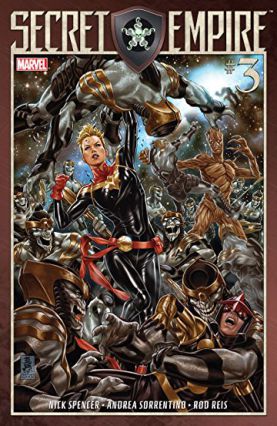
Quill and the Guardians’ unsuccessful attempt to get help for Earth from representatives of various galactic powers is a welcome bit of comic relief. We continue to get a diverse mix of snapshots and perspectives of how things are going in this brave new world – including Carol and Alpha Flight in space, the Punisher, as well as the principal players like Natasha and Maria Hill, Stark and Barton, and of course Rogers and Zemo and co.
We also get glimpses of what’s going on in the esoteric, otherwordly space where the ‘real’ Steve Rogers apparently is.
What’s remarkable, thinking about it, is how seamlessly all of this flows together – all these different elements and narratives – without feeling fragmented or disconnected.
There are parts of this that don’t really speak to me (I couldn’t care less about how the Punisher plays into this); but, generally speaking, there’s still good characterisation and dynamics here. The Hydra side of things is still interesting to see unfold, but actually it’s still Natasha at this point who is the most interesting figure.
Secret Empire #4 takes a baffling and entirely unnecessary detour, the bulk of the comic taken up by Rogers and his people and Stark and his people being invited to dinner with Ultron/Pym.
Essentially, both sets of characters are here to retrieve a cosmic cube fragment from Ultron/Pym. While there are some vaguely entertaining moments here, the whole thing is a silly detour from everything else that’s been going on. Placed right in the middle of this saga, it makes no sense for it to take up so much space.
It doesn’t help that I’m finding the Ultron thing an annoyance anyway. The way Pym/Ultron was brought back (in the pages of Uncanny Avengers) and then the way it was ‘resolved’ was annoying in itself. What was portrayed as a final solution to the Ultron problem was really never looking like anything of the sort: but to have him back on Earth so quickly is just irritating, rendering that whole arc impotent.
And then to have him play this random role here, in the midst of everything else that’s going on in this storyline, is just a bad writing decision.
Secret Empire #4 adds virtually nothing to the overall story or continuity and is, frankly, just annoying. There is a much better tidbit at the end, involving a diplomatic incident between Rogers and Namor, but that’s just about all this chapter has to offer.
Secret Empire #5 puts things back on a better track very quickly, with a captured Black Widow being interrogated by Viper.
Seeing these two face off against each other, though brief, is a pleasure – especially when Natasha takes glee in revealing that she has played Viper and has her compromised. Given what comes later, it’s nice here to see Natasha out-think one of the bad guys. It’s also wholly appropriate that Viper has been making her own arrangements behind Steve Rogers’ and Hydra’s backs, as the idea of Viper as a pure idealist without self-interest doesn’t really work.
What’s great here too is the completely unhesitating way Viper instantly executes her two Hydra henchmen the moment she realises Widow has her compromised.
In keeping with the previous chapters (notwithstanding Secret Empire #4), this chapter moves very quickly between different elements of the overall narrative.
Stark’s visit to Wakanda to plead with T’Challa for a cosmic cube fragment is a particularly interesting scene, particularly on account of T’Challa’s refusal and general attitude. What T’Challa’s problem is here is unclear – his implication that Stark with a cosmic cube could be just as dangerous as Rogers with one may have some basis in past experience, but doesn’t really make sense in this context, given that *this* Rogers is clearly a Hydra maniac.
I sort of scratched my head a little with this bit of characterisation, which felt like the writer being a little too clever or enigmatic – to the point where it doesn’t really make sense. While we’re on that matter, there are some characters in particular whose characterisation doesn’t feel very respectfully handled throughout this saga, chief among them Thor (Odinson) and Wanda (Scarlet Witch).
Also, the whole issue of the cosmic cube fragments does very quickly become the literal McGuffin of this whole saga, with Stark and co on one side and Rogers on the other, both trying to acquire all of the cube fragments – essentially, in order to write, rewrite or correct reality itself.
For a story that – when taken in its full context, meaning all of the months and months of build-up – has generally been so intricate and clever, it’s a little unsatisfying to know this early on that the race to acquire these McGuffins is what’s going to resolve this storyline at the end. Particularly when there are still five chapters to go.
In fairness, the cosmic cube was the key factor in this entire storyline from its very inception, so it was always going to factor into the resolution. But knowing – so far ahead of the end-game – that it’s literally the magicky total fix that’s going to set everything right tends to sap some of the drama and tension out of this story.
As soon as we know the cosmic cube fragments are the key, most of the tension begins to evaporate from the drama and from Secret Empire.
It then simply becomes a case of admiring the concept and the execution rather than being enthralled by the plot. With five issues still to go, that’s a bit of a problem.
Added to this is the fact that we’ve already discovered the ‘real’ Steve Rogers (or whatever aspect of the real Steve Rogers this is) in his strange, limbo dimension – hence, we know already that the ‘real’ Steve Rogers is there, just waiting for the writers to craft a scenario by which he can reclaim his life and oust the imposter.
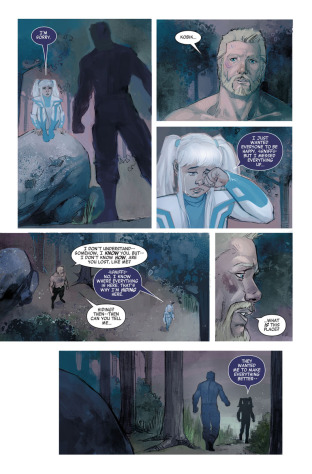
Which again removes a lot of the tension or suspense by showing us – too early – how this is all going to get resolved.
Again, in fairness, there was probably no other way to pace this: had this version of Rogers mind, consciousness or spirit – whichever it is – been revealed only in, say, Secret Empire #9 or #10, we’d have been annoyed that they’d just dropped this convenient solution in there at the last minute. As it is, it comes early, so that we can let it unfold more slowly; but it’s still a convenient plot contrivance to allow the story to be resolved.
And having it here this early – like the cosmic cube McGuffin – simply undermines the story by choreographing the finale too obviously.
The Red Skull showing up in this purgatorial realm also adds to the confusion; though there are so many reveals and turns in even just this chapter – letalone the whole story – that we almost lose our sense of suspense.
However, accepting Secret Empire on those terms, there is a lot going on here in this book, most of it interesting, and with a real sense of tension and build-up. Aside from Wakanda, we also get a lot with Stark and the resistance and there’s some bleak poetry to this side of things.
Other elements, however, feel a little pinball-machine-like, like we’re bouncing a little too much all over the place – to (apparently) Bruce Banner at the end, for example.
It culminates with Rogers’ and Hydra’s attack on the resistance base. There’s still enough of interest here, and done with enough flair, that the reading experience is still engaging – even with the major problems highlighted above.
But those problems continue to undermine the story as it goes on.
Secret Empire #6 is continues to juggle lots of characters and elements, with varying results: but much of it very good.
And, again, the character who shines brightest through the story continues to be Natasha Romanov. Her frank talk with Miles Morales about her “generation” being responsible for the mess everyone’s in is one of the very best, most meaningful passages of this entire run of comic books. It says a great deal about where Natasha is in her head and in relation to this whole situation, and it also says something about how the current dynamics are being shaken up in terms of the older, classic characters in relation to younger, newer characters.
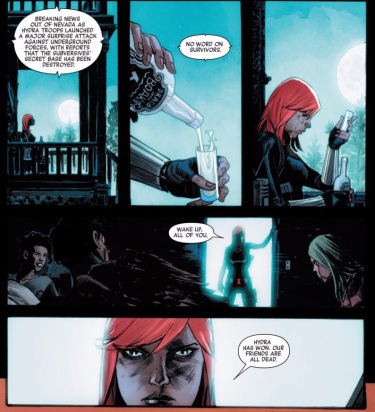
There’s a genuinely moving image at the end, when Natasha hears the news of Hydra’s attack on the resistance base, where a tear rolls down her cheek as she fixes herself what looks like a scotch. Immediately, she goes to gather her young team; and her words – the words that close the comic – are perfect. “Wake up, all of you. Hydra has won. Our friends are dead. Tomorrow, we kill Captain America”.
It’s the perfect cliffhanger; but what works so well too about it is that there are few ‘hero’ characters in the Marvel Universe who could deliver those lines and have them be perfectly in keeping with their nature – Natasha is one of them.
And Secret Empire, even if I’m repeating myself here, has raised my regard for Black Widow higher than it’s probably ever been.
There are decent bits of characterisation for some of the lesser players too, such as Nadia (Wasp) getting a couple of good moments. But, really, the two characters who really are the best written throughout this storyline are Rogers and Romanov.
Hearing Rogers’ own inner monologues and rationalisations across the course of these books is always interesting. And here, his manipulation of the resurrected Bruce Banner provides another reminder of how blinded by idealogy and fanatacism this Captain America is – and how little compassion or inter-personal skill he has.
There’s so much else jammed into this single chapter – though ‘jammed’ is probably the wrong word, as it implies an ill-fitting cramming of elements and that’s not what is going on in these books; on the contrary, it never really feels like too many elements are being juggled, but that everything flows together meaningfully.
Here, we also get the big showdown between Captain America and ‘Iron Man’ (or Stark AI), which is suitably meaningful in dialogue terms. The direct throwback to Civil War is both obvious and necessary; though it isn’t clear to me whether Stark is entirely sincere in the things he says to Rogers or not.
Elisa’s intervention to remove Rogers from his confrontation with Stark is, at this point, confusing – though it makes more sense later on.
At this point, when I was first reading this chapter, I thought Elisa intervened because she saw that Stark was somehow going to get through to some part of Rogers – and that she intervened to prevent any successful appeal to his better nature. I may have been reading more into this than was intended by the writer, however.
Even after all this, there’s still more going on in Secret Empire #6 – and I have to skip over some of it. But having Ben Grimm throw down against the Hulk felt like a welcome nostalgia kick amid an otherwise bleak backdrop, while Red Skull’s interaction with the other Steve Rogers in the weirdy purgatory-type realm (he calls it “hell” literally) is suitably surreal and unsettling.
Secret Empire #6 is generally another high point in this saga, hitting the mark at multiple points. It does most of what you’d want it to – provides a fast moving, fast evolving story, strong characterisation and compelling snapshots, and has twists and turns right up to the last panel. This chapter is a good example of why I love reading comic books, particuarly Marvel comic books – and even big ‘event’ Marvel comic books, even with their erratic track record.
Because there are these genuinely superb moments or even superb runs – and this is what I come for every time, even if I know in my gut that the finale, when we get to it, probably isn’t going to live up to everything else.
Secret Empire #7 provides us finally with the showdown set up in previous books – between Black Widow and Captain America.
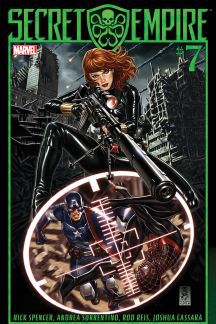
This is a showdown I had been waiting for: chiefly to see a merciless, angry Natasha Romanov hunt down the imposter Rogers and make him pay. The cover certainly captures that dynamic very nicely and promises everything that the ending to Secret Empire #6 hinted at.
As usual, there’s interesting bits of characterisation elsewhere too. In this instance, Carol Danvers’ admission that she deserves to “pay” for her mistakes (but that everyone else shouldn’t have to) is a genuinely moving moment: all the more so, perhaps, because it further plays into the sentiments Natasha had been expressing in the previous issue about her “generation’s” mistakes being to blame for allowing this whole grim situation to unfold.
This idea of the guilt and self-recrimination some of the older characters are feeling (Carol, Natasha, Sam, Stark, Clint) is very interesting and also has a lot of potential beyond Secret Empire; I hope that these themes continue to reverberate after this is all over.
Here, however, it’s all about Widow closing in on Captain America on the steps of the Capitol. And this really is compelling stuff. The dialogue between Natasha and Morales as they approach the scene is particularly good. But what really got me in the gut here is Natasha sending Morales into the back to fetch something for her and then activating a window to shut him in so that he can’t come with her.
What’s so strong about this is that her motivation is two-fold: on the one hand, she wants to be the one to put down Rogers, but also, on the other, she wants to protect Morales from the struggle of having to kill Captain America.
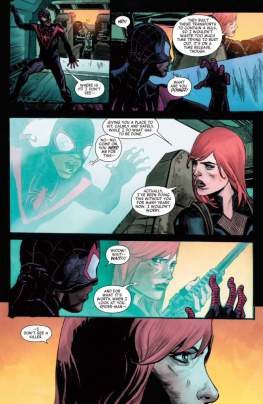
It’s her compassion for Morales that’s genuinely touching here. Previous chapters have built up this sense that Natasha was – perhaps selfishly or unwisely – using kids to fight her war against Hydra. Maria Hill basically says this to her in a previous chapter. And it’s always been a case of Natasha pushing them too hard or asking them to do more than they were naturally capable of.
But here, she shows – at the end – that she knows where the line is; and that she has enough sensitivity towards Morales to spare him this situation, particularly as he has been obsessed with and plagued by this vision or prophecy of him being Captain America’s killer.
It’s a really superb moment. And this, again, is a really superb Black Widow story. What’s more, we also get the pleasure of seeing her take down the Punisher when he comes to stop her. This too is a bad-ass Widow moment.
Immediately, however, we get to a moment we’ve been seeing in comic books for over a year by now – Miles Morales (having escaped his confinement) has approached Captain America on the steps.
And this, it has to be said, is where the scale and scope of this entire thing really comes back into focus – the sheer length and depth of the preparation and build-up to this storyline.
It was in the pages of Civil War II a year ago that we first saw the images of Morales holding Captain America’s bloodied, battered body outside the Capitol – a vision of the future provided by the Inhuman Ulysses. That image, which was reappeared several times, was a powerful one.
And now, all this time later, after countless intervening stories and twists and turns, here we are – at that point and in that place.
It’s a fascinating moment – and one that has you wondering as your eyes move from panel to panel or you prepare to turn the page. Which way is it going to go? The way of the prophecy/vision… or somehow not?
The dynamics are so rich here. Morales approaches the familiar, pre-destined scene cautiously, nervously. Rogers, on the other hand, recognises the moment fully and seems entirely at peace with it. The unforeseen element – which had been entirely absent from Ulysses’ vision back in Civil War II – is one Natasha Romanov.
It is Natasha’s intervention that stops Morales from fulfiling his ‘destiny’ – and costs her her own life.
It is a disquieting moment – sublimely rendered on the page. I had not seen it coming – I didn’t think we were going to lose Natasha. It is also confusing. Though, in fairness, I’m not sure Ulysses’ vision specified that the image of Morales holding a ravaged Captain America meant it was a DEAD Captain America – just a badly beaten and barely-conscious one. That scenario – from the vision – does still play out after Natasha’s death, with Morales beating Rogers to within an inch of his life.
It is only the intervention of Nadia that stops him from finishing the job.
Rogers appears as confused as I was, reading this – he was fully prepared to die at Morales’ hands and seems flustered. For that matter, Rogers’ seeming resignation to this predestined fate (dying at Morales’ hands) is also a little confusing, as it seems to contradict his attitude towards virtually everything else.
The theme here, I guess, is that there is no set-in-stone ‘destiny’ and that we can escape our ‘fates’ – though, as it happens, only to a point.
I mean, the ‘vision’ is still true – specifically, the vision of Morales beating up Rogers on the Capitol steps. In which case, the point is perhaps that Morales couldn’t escape his fate, but that he interepreted it wrongly in the first place (in which case, this is all about interepetation).
However, Natasha wasn’t featured in Ulysses original vision at all, which raises further questions. It gets more confusing than that, however. Because everything here – in Secret Empire in general – is an altered reality (but not an alternate reality, strictly speaking).
So how reliable can a vision of the future within an altered reality be?
Was Natasha an unknown variable? Why was she absent from Ulysses’ original vision? Was she not *meant* to intervene here?
Are my questions making any sense? Does anyone even care?
I do. But I gave up trying to get a handle on it and decided to just try to enjoy the book on its own, dramatic terms.
Putting the puzzling questions about prophecy, predestination and visions aside, this whole sequence does work superbly on a dramatic level. Visually, thematically, dramatically and in character terms, this is superb material. And Black Widow – who has, aside from Rogers himself, been the single best character in this whole series – gets a properly good send-off here, a noble death and a suitable act of selfless heroism.
And I say selfless heroism because she doesn’t get what she wants at all. She doesn’t want to die – but, more importantly, she wants to kill Captain America.
Instead, her compassion for Morales means that she dies and Captain America survives. The outcome is the opposite of what she went there to do. She essentially sacrificed herself to spare Morales from the act. It’s a powerful death, dramatically and thematically speaking, and it didn’t see it coming – I didn’t think she’d be written out with three installments still to go in this story.
But this is gripping stuff, superbly executed in terms of both writing and visuals. This is in fact Secret Empire’s peak moment in terms of quality level.
It is actually all mostly downhill from here in terms of quality.
But the Widow’s side of the story has been the best thing (after Rogers himself) in this whole business – and it is to Spencer’s credit that she gets such a good ending here.
As if this wasn’t climax enough, the story continues on, with Rogers’ confused, disoriented reaction to Natasha’s death and his own survival. His reaction here is fascinating; as is his vulnerablity (the first thing he does when he realises Natasha is dead and he has survived is to call out for Sharon). But Sharon, far from sympathising with his condition, tries to kill him.
And so the bleak drama pushes on mercilessly.
Meanwhile, the remainder of the ‘heroes’ process Natasha’s death and the sense that it means the end of resistance. If the story has been bleak up until now, her failure and mortality increases the grim sense of hopelessness: but for the sudden and timely appearance of the other Captain America – specifically, Sam Wilson.
So, arguably, Secret Empire #7 ends on a note of optimism – but it really doesn’t. This is a bleak moment; but a superb chapter, in creative terms.
As I said, however, this is as good as Secret Empire gets.
The emergence of Sam Wilson was clearly timed – in writing terms – to offset the bleakness of Natasha’s death and to provide a new hope. That’s what Secret Empire #8 focuses on.
And although it’s less dramatically interesting as what was going on with Natasha, it does make perfect sense thematically; particularly the symbolism of someone else who bears the ‘Captain America’ mantle showing up to reclaim the name, as it were, and inspire the fight.
It also works because the sense of renewed hope and inspiration that is deliberately evoked in the first few pages of Secret Empire #8 are seemingly short-lived, extinguished when Sam apparently fails and is sent plummeting down from the sky. This isn’t some heroic, idyllic hero-saves-the-day moment or some quick fix, after all.
This is a book that toys back and forth with hope and despair, come-back and set-back, several times, feeling a bit like a yo-yo. On the back of Natasha’s death, Wilson arrives to encourage everyone again; now Wilson seems to be taken out, but then – up in space – Avril (Quasar) awakens from her coma and re-enters the action to make a decisive contribution. And, as this happens, we also learn that Wilson hasn’t fallen, but is up and on his feet again.
It starts to feel a touch like a tense football match where both teams keep scoring and then conceding, winning then losing. But Quasar is the key here, whose reemergence turns the tide.
In dramatic terms, a lot of this section of the book – and indeed the whole storyline – suffers from feeling too much like contrived plot devices and convenient timings all being artificially brought together at the right time.
It feels contrived and false in places – Quasar just happening to wake up now, Namor showing up with Bucky – and this problem of inauthenticity undermines the story from this point onward. Also, if the cosmic cube fragements are literal McGuffins, there are also several elements of convenient technobabble solutions cooked up to help push the story towards its final chapters, adding to the feeling of contrived developments.
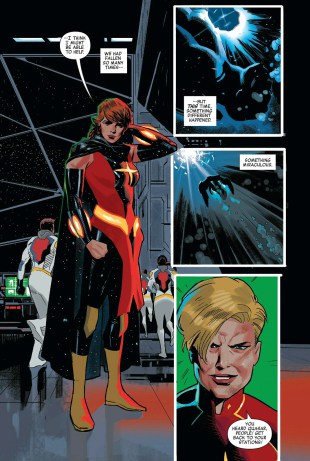
This is contrast to, for example, the earlier story centering on Natasha’s plain-and-simple quest to hunt down and eliminate Rogers, which had felt more natural and real.
Secret Empire #8 isn’t great storytelling; more worrying too for the implication that this is how the rest of the saga is going to play out. It has some good moments. I like this current Quasar, so having her be a key element in the resolution works for me in general. And I really love the shots of Carol finally getting to end her forced exile – the images of her speeding back down to earth, with an intent, focused look on her face, really work for me (as a major Danvers fan), though it also reminds me of one of the things I felt had been missing from this saga from the very start. Specifically, having Carol up in space and cut off from the events on earth was a lot less intersting than it would’ve been to have her down on the planet and involved in the struggle.
With Tony Stark reduced to an AI avatar, this whole storyline really needed the weight of a character like Carol down there in the thick of it – that key role instead fell to Natasha, which worked really well; but I still feel Carol would’ve been better in this story had she been earth-bound.
Probably the best – and most interesting – moment of Secret Empire #8, however, is right at the end, and is the apperance of a confused little girl in ‘our’ Steve Rogers’ purgatory/dream realm. The child of course is Kobik – or some aspect of Kobik. I’m a sucker for the more esoteric, mystical side of things, so this ending did intrigue me.
I also thought that Maria Hill’s brief moment was a really good one, showing her ruthlessness and her cold willingness to do what’s necessary.
Secret Empire #8, however, is a difficult, problem-riddled book – and a definite step-down in quality from Secret Empire #7. The problem now is that everything is being accelerated and moved into place for the finale, which means a lot of mechanical, contrived-feeling developments.
Secret Empire #9 fares better, in dramatic terms, from the start.
Even more elements are brought in here, with various characters able to converge on the action now that the barriers have been removed. There is a brief kick in seeing all our heroes come together at last. It’s good to see Emma Frost standing up to Rogers and playing a part; Magneto also gets a quick, wordless appearance.
But there’s still the sense that we’re descending into by-the-numbers resolution-weaving at this stage.
There are some really strong moments here. T’Challa being brought in chains, a prisoner, to Rogers by Zemo makes for an unsettling – though very striking – sight. It reminded me actually of G’Kar being dragged in as a prisoner for Londo Mollari in Babylon 5 (I forget the episode name). In character terms, it is unsettling to see someone as proud as T’Challa being dragged in as a trophy-prisoner.
In thematic terms, it is unsettling to see an African king being paraded as a prisoner by a fascist regime in America. It is also unnerving – even after everythig else we’ve seen – to see Rogers be so callous and uncaring about T’Challa, even hinting to Zemo that he approves of the Wakandan King being executed “later on”.
This isn’t a great chapter necessarily; but it’s the last time Secret Empire is good reading.
We come finally then to Secret Empire #10, perhaps holding out some semblance of hope that a big finale to a huge Marvel event won’t prove disappointing.
Unfortunately, the conclusion to this finale was so choreographed ahead of itself that there’s no element of surprise to anything; and, in general, it feels like a plot-device check-list being ticked off.
From the get-go, the giant-sized, god-like, Iron-Man-ish Captain America feels somehow both silly and appropriate at the same time.
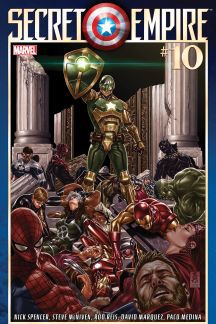
The fight between Hydra Captain America and ‘our’ Captain America is both cheesy and appropriate, feeling like the only thematically-fitting way this could’ve gone. The real Captain America had to come back and had to expel or overcome the dark imposter or aspect – it feels silly, compared to all the quality build-up and storytelling for many months, but I guess it works.
There’s nothing satisfying or impressive here in Secret Empire #10. Chess pieces are all in place to resolve the story, but it just feels like a choreographed dance, with everyone playing out their moves. Rogers managing to use the Cosmic Cube to rewrite reality in Hydra’s image lacks all dramatic power, because it gets reversed a few pages later by Kobik.
Sam, Scott and Bucky showing up to defeat evil Rogers feels like a first-draft on a storyboard rather than a meaningful or real-feeling development. Bucky rescuing ‘our’ Rogers and Kobik from the undefined magicky place they’re trapped in doesn’t really register as a thing, but more like an easy plot-resolution device that has never been meaningfully explained or substantiated.
In general, there’s nothing pleasing in this finale. Which is a shame, as there’s been so much high quality storytelling throughout the last year or so of the build-up – and which is, also, not surprising, as this is the finale to a massive Marvel event.
There’s a sense that not quite everything is necessarily going to revert back to normal – but, at the same time, there’s a sense that we’ve pretty much just hit the rest button again.
All of this being said, Secret Empire as a whole – and, in particular, the months of Nick Spencer storytelling in Captain America: Steve Rogers – has been spectacularly good: and it is difficult to argue that a predictably poor and unsatisfying finale nullifies or undermines all those months of comics.
This is simply, again, the classic and predictable paradox of big Marvel events – we all know the finale is going to be a damp squib long in advance, but we still consent to be engaged in the storytelling process and all of the set-up, because that’s where the all the great stuff resides.
It was the same with Civil War II, it was the same with IvX, it was the same with Secret Wars – it’s been the same with more or less every Marvel event in my lifetime.
The closest we’ve come in recent times to a huge event with a finale that wasn’t a total disappointment was Secret Wars – although the finale to that was also a classic reset-button moment, it was done with enough poetic flourish and dramatic flair that it didn’t feel like a dull thud.
Unfortunately, Secret Empire #10 doesn’t manage that. But I didn’t expect it to.
On the balance, I’m going to say that a lot of this Secret Empire series – particularly the stuff centering on Natasha Romanov early on – was very good. And, moreover, that all of Spencer’s work on Captain America: Steve Rogers has been superb.
In the end, we got months of utterly top-quality storytelling – which is always, on its own merit, worth it. I just wish we’d had a better finale – one that could’ve done justice to all those months of work.
But, hey, this is comic books. We know how it goes.

Road to SECRET EMPIRE: Reviewing CAPTAIN AMERICA: STEVE ROGERS #11 – 19…
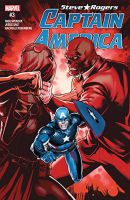
Road to SECRET EMPIRE: Reviewing CAPTAIN AMERICA: STEVE ROGERS #1 – 9…

CIVIL WAR II #0 – 9 – Full, Bumper-Sized Review…
Advertisements Share this:





